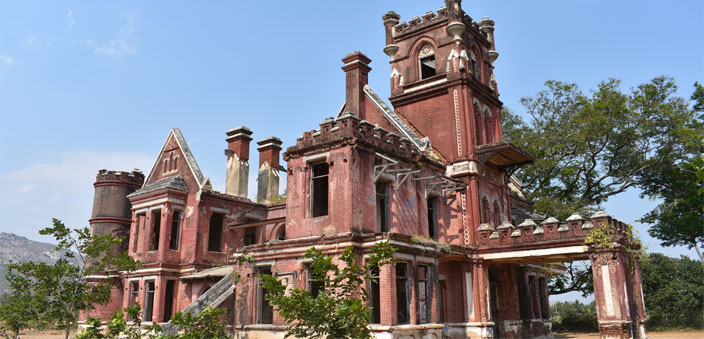Text: Nivedita Louis
Travel brings power and love back to your life
– Rumi
It was a hot summer morning, the sun was getting brighter and hotter as I waited for our van. A group of heritage enthusiasts had planned a day trip to a place called Arni, about 140 kms and three hours travel from Chennai, and I was all charged to enjoy the day. The van arrived and off we went, on the road less traveled. Arni is a temple town, well known for its famous Arni Silk, but our trip wasn’t about Arni silks…
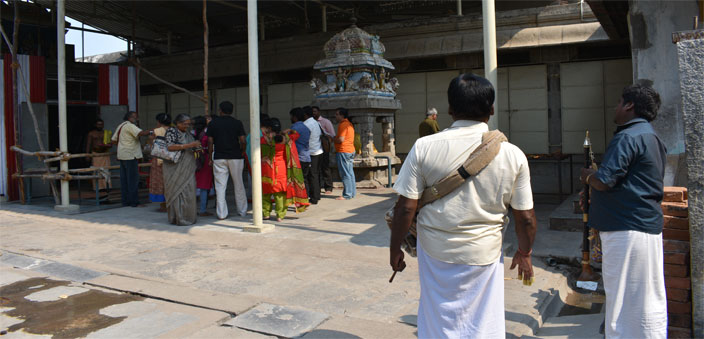
Mohan Hariharan, the renowned architect of Chennai who has designed so many theaters and schools, organised this trip, and I count myself lucky to have joined the group on this trip. The itinerary supplied to us read, “By the time you get back home it will be 9 pm. You don’t have to bring water or headache medicines, we will provide”. As the van zipped across the highway, speaking into a hand wielded microphone, Mohan gave us a small brief of the places enroute – Damel, Kaveripak, Ranipet, Arcot, and handed us a quiz questionnaire. The sheet had a clear disclaimer – “It is only for time pass – it does not matter if you do not know the answers, but the first two persons who score the most may be given gifts”.
The questions were on varied subjects – “Can you name any of the three names of Raja Tej Singh’s horse?” Pat came my reply – Pancha Kalyani, but I had a tough time remembering the other names. Someone suggested Neelaveni. But it was the quiz master who revealed the last name – Barah Hazari. “What is the state flower of Kerala and West Bengal?” read the next question, and this time the answers just flew in – golden showers and night-flowering jasmine, nyctanthes. “What is phirni?” came last, and almost all of us shouted out the answer – A Mughal dessert! By the time the questions were answered, we arrived at our first stop of the trip, and I was mentally so charged up!
The name Arni
The name of the town Arni came from the Tamil word Ar+Ani which means, “beautified by Ar tree”, Ar being the Indian laburnum. The town existed during the period of Rashtrakutas and Cholas, and came under Hoysala rule and Vijayanagara Empire. It was Maratha King Shahji, father of Veer Shivaji, who handed over Arni along with 192 villages around it to his Commander Vedhaji Bhaskara Punt in 1640 AD. During the reign of Bhaskara Punt, Veer Shivaji had visited Arni on his way to Tanjore (Thanjavur). The town with all of its 192 villages, 211 sq. miles in all, formed the Arni Jagir, thence ruled over by the Arni Jagirdars from the Punt family. The Jagir was abolished under the Zamindar Abolition Bill, 1948, when the annual revenue of the Jagir was about Rs. 2.5 lakhs per year!

The van crossed the nondescript Arni Fort area – where nothing remains except the Gori Maidan or Parade ground. Once there existed a fort and a moat. The exact year of construction of the fort is not known, but assumed to be around 1800-1820 by the Nawab of Arcot, later expanded by the Arni Jagirs. The fort area once had more than 100 barracks, stables for horses and elephants. It also housed a sub-jail, a few old Jagir bungalows, an Officer’s Club and the Coronation School. We craned our necks to see the tall obelisk at its center. “That will come later”, said Mohan sir, and the van screeched to a halt in front of a temple gopuram. As we got down from the van, a nadaswaram and thavil (tamil musical instruments) party surrounded us, and it was a divine feeling, being escorted into the Kailasanathar Temple.
The Kailasanathar Temple
The temple was under renovation for Kumbabhishekam – an elaborate function where the crown of the gopuram is bathed and sanctified with holy water. The crown here is made of copper, filled with kodo-millet grains. Kodo millet is very special as it is difficult to de-husk. The ancient Tamil practice of storing grains in large copper sealed vessels atop temples was to ensure food during floods, and seeds during famines. During floods the temple gopurams were the tallest structures where waters couldn’t reach, and during famines, it was the safest place to store. The grains remained intact for years when stored in the air-tight copper vessels, and were safe to use. Almost all Tamil temples have this practice of storing the grains even now. The grains of this temple were being replaced after a period of 12 years during this Kumbabhishekam, and it was a treat to watch.
The east facing temple has a five-tier gopuram that was concealed for Kumbabhishekam with palm leaves. As we entered the temple, we saw the Nandi Mandap, Dwaja Stambh and Balipeetam, all made of green granite stones. The temple’s sanctum must have been built during the late Chola era – probably 12th-13th century, with additions by Vijayanagar and Sambuvaraya Kings. The outer prakara has a beautiful Vanni tree, which is the sthala-vriksha, 1008 lingams all lined up, including the Brahma lingam, Jyoti lingam, Kasi Lingam, Vayu lingam, and a Vallabha Ganapathy dating back to the Chola era.
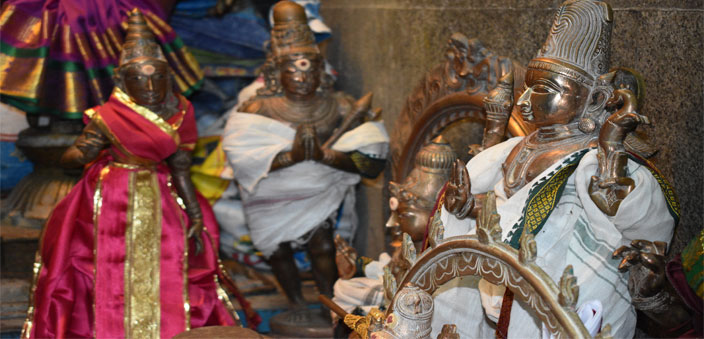
There are idols of 63 Nayanmar-Saivite saints, and a separate sub-shrine for Lord Muruga. The temple authorities were kind enough to show us a few Chola bronzes kept under tight security. The Nataraja occupying the center of the lot was so graceful that I almost forgot to breathe. With hair flowing wild in the wind, one leg holding his ear ring and his four arms circling wide, it was sheer poetry in metal. The Somaskantha idol is equally ravishing. The dwar-palakas are so huge and are of granite.
We walked past the mandaps that have intricate carvings and came to the right side of the prakara where the Moolavars or the main deities of the sanctum have been moved to. Enshrined in a small asbestos enclosure, Kailasanathar and his consort Aramvalar Nayaki stand amidst all cacophony. The temple management had arranged a special pooja for us and with the divine music and chants of the priests, we conducted a prayer. We were honoured with garlands, a piece of intricately woven Arni silk piece with the motif of the legendary Pancha Kalyani, the horse of Raja Tej Singh, and a set of books by the temple management. We came out of the temple spiritually appeased and mentally satisfied. The holy pond is located just adjacent to the temple.
As the van approached the next stop, the sun was high. The Gori Maidan was used as a proper parade ground during the Raj. The center of the ground has the 45 feet tall Robert Kelly memorial obelisk. The memorial was erected in memory of the Chief Commander of the Western Army 4th Regiment Infantry, Robert Kelly. Robert Kelly was the Commander who fought for the British along with Mahmud Khan aka Maruthanayagam and secured Arni Fort for the British. Unfortunately, Kelly died in a duel with his subordinate Col. Vigors in 1790. The duel is said to be a fall out due to Mrs. Kelly. The memorial was curiously erected by the son of Col Vigors, Lt. Col. Urban Vigors. Was it out of valour or atonement or love, we will never know.
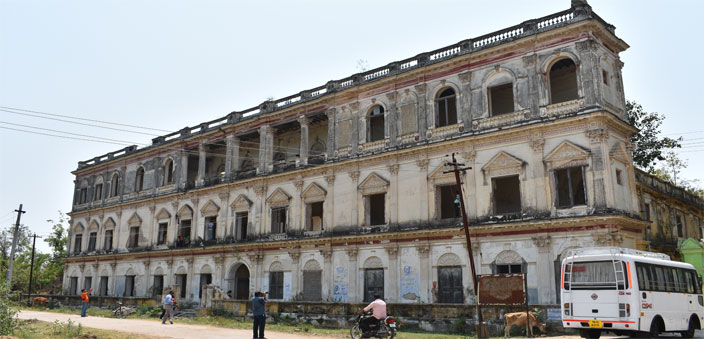
The capital of Arni Jagirs
Our next stop was the Capital of Arni Jagirs – Sathyavijayanagaram. The capital of the Jagir lies on the banks of River Kamandala Naganadi, about 5 km from Arni village. It was established by Venkatanatha Rao in 1825. It is said to be named after the Moola Uttaradi Mutt Jeeya Sathya Vijaya Theertharu. The once bustling Rajapattai (Royal Courtyard) now stands in stoic silence. The houses leading up to the dilapidated palace are those of the ministers during their reign, I muse at the century old street. The neatly lined houses are now devoid of any human movement. The Diwan Khana or Sri Vilas has been the abode of the Jagirs for over 100 years. It housed their women folk and children and was a place to entertain their guests. Built in three tiers, all that remains of the palace are the walls and wood-robbed windows.
There is a plaque that says “renovated in 1876”. The arched windows, the lime polished walls, high columns, enormous corridors, all stand testimony to the fine architecture, the style called Stuart Architecture. The columns are distinctly Corinthian, the architecture a mix of European and Persian. A fine door-like concealed wall, complete with a padlock, has been built on the first floor, to confuse the opponents. The hand polished lime mortar has such smoothness that it can only be felt by running our hands over it. The high columns have unusual semi-circular bricks and a circular granite to ensure full support. The banisters are finely polished, and the pillars have beautiful stucco work of lions and faces.
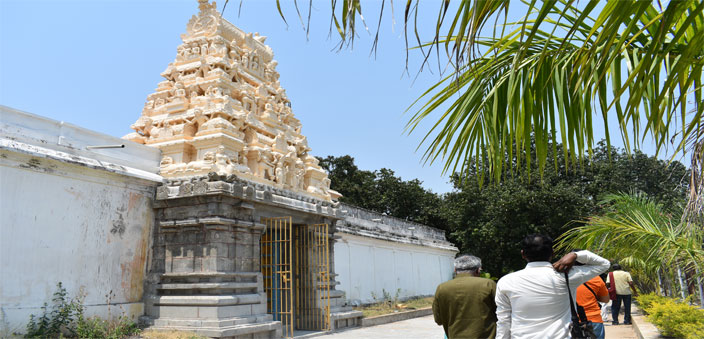
There are fine paintings on the walls and stucco peacocks grace the doorways. The lengthy corridors are held together by an overgrowth of banyan shoots, the entire structure is now at the mercy of the vegetation to not give up on it. The palace is said to be sold to the government by the Jagirs. The harem of the palace has a separate entrance. The plaque mentioning renovation done in 1876 is found in this part of the palace.
The adjoining Queen’s Palace has been renovated by the government as also the Durbar Hall. Please understand, renovation here means scrapping the original flooring and relaying the floor with vitrified tiles. There is a huge well that brims with water even in the hot summer. The fountain and swimming pool have also been renovated, yet stand high and dry without water. The entrance door of the Queen’s Palace has the emblem of the Jagirs affixed in glass – “Per Deum Et Ferrum Obtinui”, meaning “By God and my Sword I have obtained”. A government office also functions inside the premises, as we gawked at the last piece of furniture left in the palace ground – an ornate table, now used to hold a few books. This part of the palace has been well-maintained.
The Jagirs had also instituted a Jagirdar of Arni Gold Medal for outstanding students in Physics and Chemistry at the Presidency College, Madras, in 1877. The medal reads “Presented in loyal Commemoration of the visit of HRH Prince of Wales to Madras by the Jagir of Arni”. Two Nobel Prize recipients have received the Arni Gold Medal – Sir C.V. Raman in 1905, and Dr. S. Chandrasekar in 1930. Somewhere around 1936, this practice was discontinued. The Jagirdars had a lavish life style – at one time they owned 182 cars, all imported! They participated in betting heavily at all the races around Tamil Nadu – Chennai and Ooty mainly, and lost a fortune. The palace stands mute testimony to the lives of a clan so well-lived, that it got to its place by the sheer strength of sword and the grace of God.
The Jain temple at Poondi
As the sun sears our skin, we escape into Arni Aryas hotel for lunch. A sumptuous lunch and some banter later, we are off to our next stop, a village 3 km away from Arni – Poondi. The 13th century Jain temple at Poondi village is called Arugar temple. The temple is an architectural marvel, a stone structure standing atop a brick basement, built by Sambuvaraya Prince Veera Samban. It is an ASI (Archaeological Society of India) protected monument. Mentioned in Chola inscriptions as Ponnezhilnathar temple, it has been mentioned in 13th century Sambuvaraya inscriptions as Veera Veera Jinalayam.
The three-tiered gopuram has interesting stuccoes that have been sand blasted recently. Renovation work was in progress as we marveled at the huge five feet tall Parashvanath inside the sanctum, in standing position, his head covered by a five-headed snake. The tail of the snake reached his leg and there are three more panels with all 24 Tirthankaras. Around the sanctum we find Dharma Devi, Brahmadeva, Jwala Malini, Padmavathy, Chakreswari, Chandraprabanath. The Navagrahas are called Navadevatas in Jain temples. Here, the Navadevatas are placed in an old dilapidated brick structure. There are two more Tirthankaras in the Mukha Mandap. The sub-shrines are supposedly later additions to the main sanctum.
The Hindu deities are worshipped by Jains as Yakshis, and so we find Hindu deities of Saraswathy, Lakshmi and interestingly, Ayyanar, in the outer prakaras. As we come out of the temple, we were greeted by the person in-charge, who gave interesting information about the Tamil Jains. He claimed about 1000 Jain followers around Arni. He also explained about the annual Aradhana Festival held at the temple during the fifth day of Tamil Thai month, roughly falling in the second fortnight of January. The Jain festival Mahavir Jayanti is also celebrated with equal gusto.
As we exited the temple, bunches of mangoes greeted us as we jumped with glee. The temple is surrounded by a huge mango orchard, and we struck a deal with a few women working there. We bought our mangoes and moved on to the next stop, 13 km away.
The ‘shooting box’
The weather is swelteringly hot, and we sweat profusely. As we take a turn from the main road, thick vegetation surrounds us. The trees were planted by the Jagirdars to make the area surrounding their hunting palace, cool. Once teeming with game like wild boars and deer, the tropical forest wears a dull, dreary look. The air gets colder as we move further, greenery cloaks us. Paddy fields on either sides of the road greeted us with green carpets. The imposing red building at the end of the road loomed into vision and we alighted from the van, spellbound.
As the team walked to and fro admiring the building, I scrambled to the nearby fields to get a good shot of the building. The Poosimalaikuppam Palace, called the “shooting box” is a lovely piece of architecture, designed by W.N. Pogson. Built like the Windsor Castle in 1860 by Srinivasa Rao Sahib, this was called the “shooting box” as the Jagirdars entertained their guests here. This is said to be constructed by the same contractor who built the Spencers building in Chennai. Locals call this place “Kannadi Maligai”, meaning the Glass Palace.
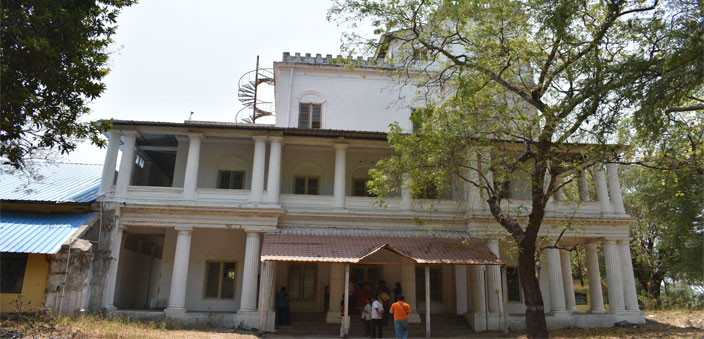
The Madras roofing is evident as we stand mesmerised on the verandah. The Madras roofs of this palace are made of steel, bricks placed at 45 degrees from the wall, and lime mortar, gravel and sand connecting them. The graffiti on the walls of the abandoned palace are so horrifying, some literally, with all spooky movie names and dialogues written all over. The lower floor has few rooms, all equipped with a fire place. I wonder what a fire place must have been used for in the humid area.
The ornate ceilings have murals that have started peeling off. A bunch of “busy-bodies” slept on the floors, and we climbed the intricately polished steps to the first floor. The same type of rooms with beautiful roofs and columns look inviting. No two corners of the building are the same, each designed in a unique way. The sit-out on the northern side has cast iron pillars, which have the dual purpose of draining the rain water, and support. Interestingly, these pillars/pipes have the “Made in Glasgow” seal still intact, with the year 1860 imprinted. Here too, we find rounded ‘corner bricks’ in the palace.
There is a separate kitchen outside the palace, a well, and a large pigeon tower. The pigeon tower has multiple crevices for the pigeons to nest. May be the inhabitants of the palace loved to rear pigeons. Now the pigeon tower has huge termite nests and we didn’t venture inside for fear of upsetting the army lurking underneath. The group scrambled for the proverbial group picture in front of the palace. Someone whispered, “This palace was built for the kept European mistress of the Jagirdar…and that’s why we find the fire places and all that European touch. There is also a secret passage from the Sathyavijayanagaram Palace to this place…”
As the setting sun simmered, I stood behind one of the bay windows, looking at the endless fields in front of me, and the snaking road. If the story was true, what could have been the thoughts of the lone mistress kept here, far away from the town and civilisation? How would she have lived in the absence of company, thousands of miles and continents away from her family? A lump formed in my throat, as I thought of the poor soul.
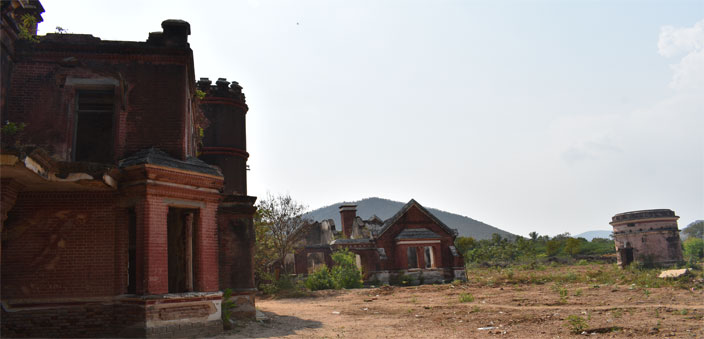
Both the palaces of the Jagir are practically in ruins now, repeated appeals from heritage enthusiasts and local people to the government have fallen on deaf ears. With the help of a few architects, Mohan has planned to submit a proposal to the state government to preserve the buildings, as both the buildings come under the control of the state government. With child-like enthusiasm, this senior citizen architect shows his plans for reviving the Poosimalaikuppam Palace as the van moves on. I fervently wish someone will pay heed to his requests and will do something to save the heritage structures.
The van moves into town and I start looking out for the famed sweet of Arni – the Makkan peda. The sweet-tooth in me refuses to be appeased, and at the sight of the sweet shop we all hurriedly clamber to the platform. Makkan peda is said to be the royal dessert of the Arcot Nawabs. Made of maida and unsweetened khoya (thickened milk), it is filled with nuts – raisins, pistachios, almonds, walnuts and cashews. The delicacy looks like gulab-jamun, but is its richer variant. As we taste the first Makkan peda, all slithery from sweat and heat, the first drops of rain fall on to the pavement. A sudden rain lashes the area, as I jump onto the platform, savouring the Makkan peda and the surprise summer showers. As it gets dark, the group pulls a reluctant me back to the van, and we set out on our return journey to Chennai.

